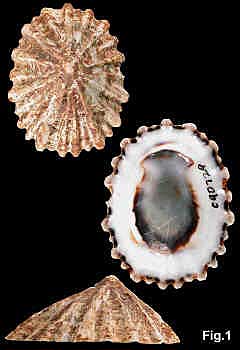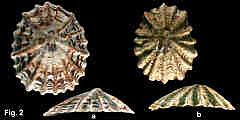|
|
|
|
|
Patelloida alticostata (Angas, 1865) Description: Shell heavy, narrower anteriorly, widest at posterior third. Apex slightly in front of centre. Exterior sculpture of 13-26 strong axial ribs with no secondary ribs between. Margin strongly crenulate, usually black or grey internally, sometimes white. Interior porcellanous white; spatula black, grey, or brown, outlined with black. Exterior usually eroded, but with characteristic black cobweb lines between ribs. Size: Up to 56 mm in length, commonly about 35 mm. Distribution: Endemic to Australia: The Entrance, NSW, to Kalbarri, WA, including Tasmania. Habitat: This species lives on exposed or moderately exposed rocky shores, in the low intertidal and shallow subtidal. Around Sydney it is more common subtidally than intertidally. It always lives on rocks which are bare to the naked eye. Because the rock surfaces in the low intertidal are covered with cunjevoi, Galeolaria worm tubes and large algae, its habitat is restricted to small bare patches of rock between these plants and animals. Subtidally, it is more abundant in patches of rock kept bare by the grazing of sea urchins. There have been four studies into the life history of this species. Black (1977) looked at populations on Rottnest Island, WA, where it is very common. Creese (1980) and Fletcher (1987) looked at populations at Cape Banks, Botany Bay, and Parry (1982) studied the species at San Remo, central Victoria. There is much variation in diet and predators between these different regions of Australia. Iin NSW the diet is the thin film of microalgae on the rock surface, and very small pieces of filamentous green macroalgae, but in Victoria and Western Australia coralline macroalgae forms a large component. The microalgal diet of this species is the same as that of Cellana tramoserica. C. tramoserica is able to out-compete P. alticostata for micro-algal food in the intertidal zone, causing P. alticostata to be restricted to small pockets between cunjevoi and Galeolaria where Cellana cannot feed. Cellana also kills larvae in its feeding path by accidental predation or crushing, thus preventing other limpets from establishing in its habitat. Anderson (1966) investigated reproduction in the laboratory. Sexes are separate, and gametes are broadcast into the sea. Fertilisation results in trochophore larvae which transform into veligers during 60 hours of swimming, followed by settlement over three or more days. Larvae are cast up on rocky shores by waves, wind and tides, probably at random, with only those that settle in suitable habitat surviving. In NSW, Fletcher found that spawning occurs three times a year, in March, May and October, but Parry, in Victoria, found it in December and January. Once settled on the shore, the limpets establish a home site, to which they return after feeding. Settled larvae do not spread out to areas of low limpet density or high food availability, but apparently establish themselves where they settled. This results in high population densities and shortage of food in areas of suitable habitat. Fletcher (1987) studied the growth of subtidal and intertidal populations at Cape Banks. For the subtidal population, he found the species reached 20 mm at one year, the age at which it became sexually mature. Growth then continued more slowly to 40 mm in 3 ½ years, with a maximum size of 48 mm at 6 or 7 years. For the intertidal population, growth was slower, with animals becoming sexually mature at 14 mm at an age of one year. Life expectancy was shorter than the subtidal population at 2 ½ to 3 years. The shorter life of the intertidal population was probably due to shortage of food (from being restricted in habitat by Cellana), and from physical factors such as desiccation. There may have also been predation by the common, small, boring whelk Morula marginalba. In Victoria, Parry found there was high mortality from predation by wrasses, and in West Australia Black found predation by the boring whelk Dicathais orbita. Comparison: Similar to Scutellastra peronii, but differs by having relatively smooth radial ribs with no secondaries between, and having the black cobweb colour pattern. Synonymy: Iredale (1924) named shells from eastern Australia Patellioda alticostata antelia, claiming they were smaller and more elevated than southern shells. He named subtidal specimens from Sydney beaches Patellioda alticostata complanata Iredale, 1924, claiming they were flattened and smoother. Both forms fall within the range of variation of the species. Remarks: This species shows some variation in the strength of ribbing. Shells from exposed positions show strong sculpture, while those from more sheltered positions are more weakly ribbed. Some specimens from the Sydney area may be eroded smooth, and have a white margin internally, rather than the more usual black or grey. Fig. 1 Port Jackson, NSW (C.090729) Fig. 2 a. Boat Harbour, Cronulla, NSW (C.084616) b. Sandringham, Port Phillip Bay, Victoria (C.092661) Fig. 3 Live animal. Long Reef, Collaroy, NSW (DLB5070) |


